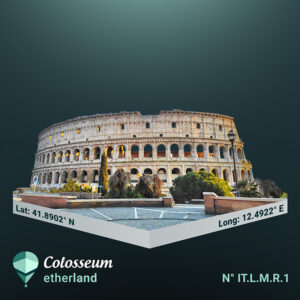 Built in the time of Emperor Vespasian, its original name was "Flavian amphitheater". The name "Colosseum" was inspired by the Great Statue of Nero or “Colossus Neronis”, which is located at the entrance of the "Domus Aurea". Made famous by the Venerable Bede, a legend says that “As long as the Colosseum stands, Rome shall stand; when the Colosseum falls, Rome will fall; when Rome falls, the whole world will fall.”
Built in the time of Emperor Vespasian, its original name was "Flavian amphitheater". The name "Colosseum" was inspired by the Great Statue of Nero or “Colossus Neronis”, which is located at the entrance of the "Domus Aurea". Made famous by the Venerable Bede, a legend says that “As long as the Colosseum stands, Rome shall stand; when the Colosseum falls, Rome will fall; when Rome falls, the whole world will fall.”
The Colosseum, formerly known as the Amphitheatrum Flavium, was a place dedicated to slave owners, nobles, and free people to watch beasts or slaves fighting in the ancient Roman Empire.
Built between the year 72 and 80, the colosseum is a symbol of ancient Roman civilisation as well as a model masterpiece and miracle in the history of architecture. The site is located in the centre of Rome, the capital of Italy, on the south side of Piazza Venezia, near the ancient Roman market.
From the outside, it is a perfect circle; with a bird's eye view, it is oval, of which the long axis length is about 187 meters and the short 155 meters, the circumference is about 527 meters, covering an area of about 20,000 square meters. This huge building can accommodate nearly 80,000 audiences. In 1980, the Colosseum was part of the historical centre of Rome and was included in the "World Heritage List" by the UNESCO World Heritage Committee as a cultural heritage.
The Colosseum was built on the original site of the "Domus Aurea" of another Roman emperor Nero, which was destroyed by the Roman fire in 64 AD. The construction was started by the emperor Vespasian to please triumphant generals and soldiers and praise the great Roman Empire. Finished during the reign of his son Titus, it is one of the landmark buildings of the ancient Roman Empire. According to the records of the Roman historian Dio Cassius, when the Colosseum was built, the Romans held a 100-day celebration and slaughtered 9,000 animals.
The architectural characteristics of the Colosseum originated from theatres in the ancient Greek period. At that time, the theatres were built on the hillside, in a semicircular shape, and the auditorium rose on the upper level of the hillside. But in the ancient Roman period, people began to use the arch structure to frame the auditorium and connect two semicircular theatres, thus forming the so-called amphitheatre which is no longer necessary to be built with a backing. The stands are divided into different areas from bottom to top to entertain audiences of different classes. It is worth mentioning that spectators can enter the venue from different arches according to the seat number, thereby avoiding congestion and confusion. This ingenious entry design is still used even in today's large stadiums.
The Colosseum was a place where human and beast performances were held in ancient Rome. Gladiators who participated had to fight a wild beast until one of them died, and there were also fights between people. There are strong religious elements in it, while also shows power and family prestige. This primitive bloody aesthetic activity casts a legendary veil on the Colosseum, which has attracted people to visit and appreciate the elegance of the ancient Roman Empire for many years. Despite the damage caused by the earthquake and bombing during World War II, the remaining half of the skeleton is still telling its majestic spirit and majestic momentum.